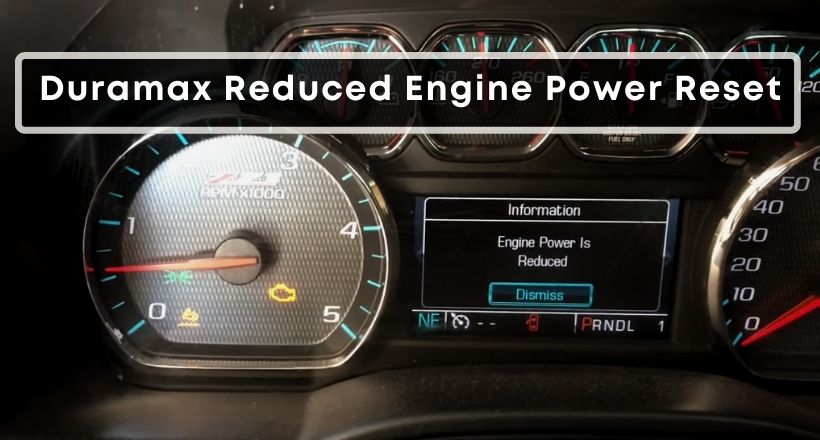“Engine Power is Reduced.”
This is one of the most dreadful warning messages for GM’s Duramax engine-based vehicle owners.
Imagine you’re cruising on the road. Suddenly, this message appears on the instrument panel, and the vehicle goes into the limp mode where the max speed is 30/45 mph.
As horrible as it sounds, this warning message is there for a reason. This guide will discuss the possible issues triggering it and the fixes you can apply.
Duramax Reduced Engine Power Reset
The first thing you can do to fix the Reduced Engine Power warning message in Duramax vehicles, such as Chevy Silverado and GMC Sierra, is reset the ECU.
Here’s what you need to do:
- Disconnect the negative battery terminal and then the positive terminal.
- Touch the terminals to each other and leave them disconnected for 10-15 minutes.
- Reconnect the positive battery terminal and then the negative terminal.
This procedure will fix the warning message if it appears due to a computer glitch.
However, if there’s a malfunctioning engine component triggering the message, it’ll reappear. In such a situation, you’ll have to use an OBD-II scanner to find out the problematic component.
For example, the P0120 and P0122 codes indicate a problem with the throttle position sensor. The P0191 points toward the fuel rail sensor, the P0087 is related to fuel lines, etc.
What Does Reduced Engine Power Mean on a Duramax?
The reduced engine power is a fail-safe mechanism that’s automatically activated when the vehicle’s ECM or PCM detects an issue with the engine that’s preventing it from performing at the optimal level.
A modern vehicle engine consists of numerous components, with each assigned a specific task that collectively ensures the engine’s efficiency and smooth vehicle operation.
However, should any of these components malfunction, the engine’s efficiency diminishes, and the vehicle’s performance degrades.
Operating the engine under these conditions without addressing the issue can lead to permanent damage.
That’s why you get the reduced engine power.
It’s a safety mode activated by the ECM to prevent the engine from any permanent damage.
In many cases, it’s accompanied by the Check Engine warning light on the instrument panel. However, many car owners report no warning lights other than this message.
Although it appears in a lot of vehicles, our focus in this post will be on the GM vehicles that feature Duramax engines, such as Chevy Silverado, Chevy Tahoe, GMC Sierra, GMC Yukon, etc.
Related Post: GMC Acadia Steering Assist is Reduced
13 Reasons For Duramax Reduced Engine Power Message
As I said earlier, this warning message can appear for a lot of reasons, and checking for each one of them will take a lot of time.
Therefore, you should use an OBD-II scanner (like this one) to get the DTC code(s). The DTC code(s) helps you identify a potentially malfunctioning component/sensor.
This approach saves considerable time and allows for a systematic examination of each element, streamlining the diagnostic procedure.
1. Ground Connections
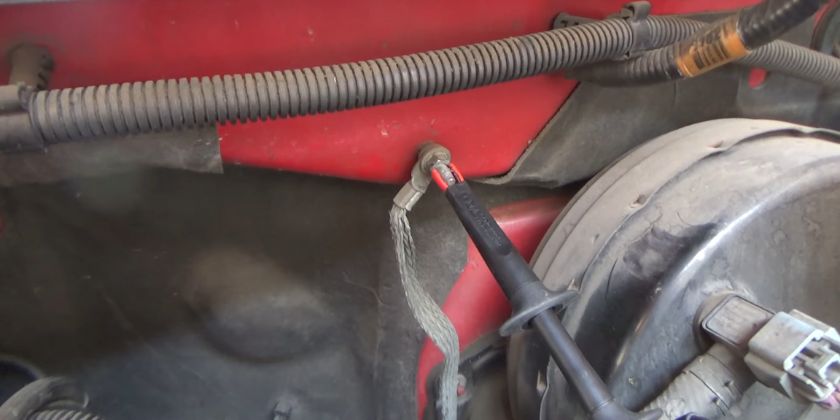
Oftentimes, what may appear as a serious car problem can stem from seemingly minor issues.
One such issue is the ground connections. Most vehicle owners take them for granted as they don’t go bad as often.
However, a loose or corroded ground connection in the engine compartment can cause it to not perform as usual, resulting in the rescued engine power warning message on the dashboard screen.
Therefore, before anything else, we’ll check ground connections for components such as the battery, alternator, engine block, throttle body, etc.
Make sure that these ground connections are tightly secured, corrosion-free, and paint-free.
2. Throttle Position Sensor
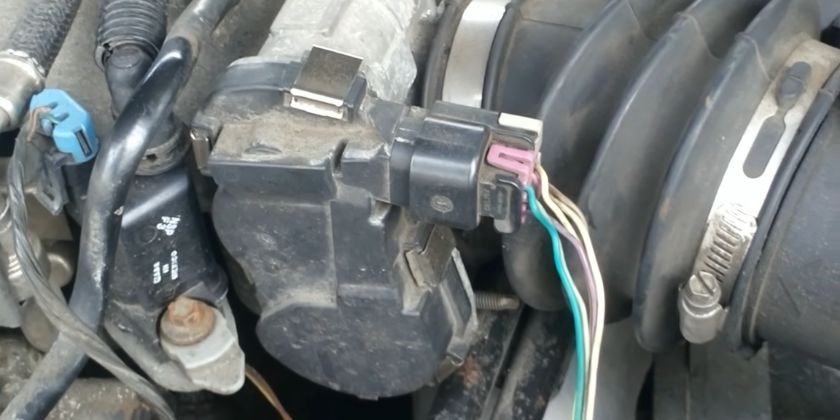
If you’ve got the reduced engine power message and the OBD-II scanner is giving the P0120, P0122, or P2135 code, the problem is likely to be the throttle position sensor.
As you press the accelerator pedal, the throttle valve opens, allowing the air to flow into the engine’s intake manifold.
The throttle position sensor (TPS) is mounted on the throttle body and measures the position of the throttle plate (how much it opened/closed at a given point) before sending it to the ECM.
Based on that data, the ECM determines the timing of the fuel injection for optimal combustion.
However, if this sensor malfunctions, the ECM will get incorrect data, resulting in poor engine performance and a reduced engine power message.
For example, the 2006-2011 GM vehicles, such as the 2009 Chevy Silverado, 2010 GMC Yukon, etc., come with two TPS sensors. If one of them goes bad, there will be a difference between their calculated data.
The ECM will detect this difference to be a result of some malfunctioning and will reduce the engine power as a precautionary measure.
Therefore, you need to test this sensor with a multimeter to confirm whether it’s working or not.
Sometimes, the sensor itself is working, but the wires in its harness are damaged, causing the latter not to work properly.
I’ve also observed that the sensor starts to malfunction if the connector has dust/debris accumulated.
So, make sure to check for all these areas before drawing any conclusion.
If you’ve indeed found the sensor to be not working while the wires and connector are good, replace it.
3. Throttle Body
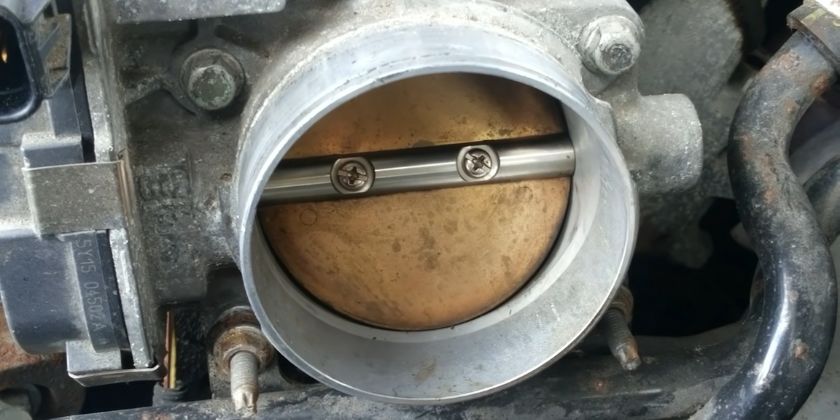
That’s because the carbon deposits can accumulate over time inside the body, which can prevent the throttle valve, aka the butterfly flap inside the body, from opening or closing smoothly.
This will cause the airflow into the engine to be irregular, leading to a reduced engine power message (as the ECM will detect the engine’s performance degradation).
Therefore, I recommend you clean the throttle body and the valve with a throttle body cleaner, such as this one.
You can also check the connector, as it can get loose, dusty, or corroded and can cause the throttle body not to work. The same goes for connector wires. Make sure they’re not physically damaged.
On the other hand, if you’ve recently cleaned the throttle body and have been getting the warning message since then, it can be due to the throttle valve’s misalignment.
Many mechanics remove the throttle valve temporarily to clean the throttle body but fail to match its alignment when reconnecting.
This misalignment can cause the valve to get stuck open or close, affecting the amount of air entering the intake manifold – resulting in the same reduced engine power message.
On the other hand, if you’ve cleaned the throttle body, checked its wiring/connector, and still getting the same error code, I would recommend testing the throttle body motor, as shown in the video below.
4. Accelerator Pedal Position Sensor
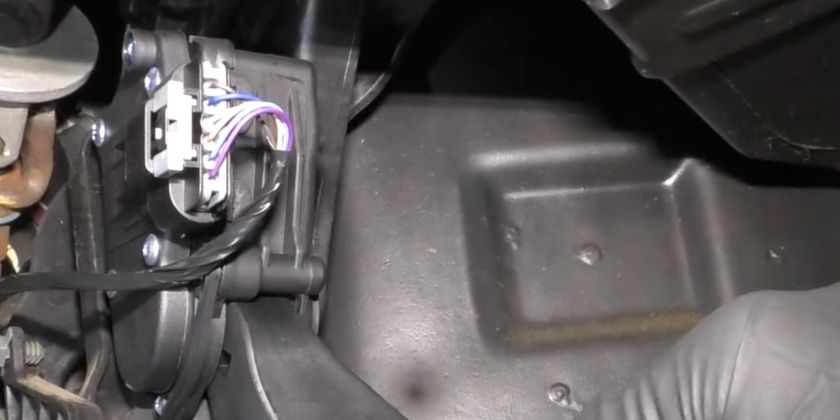
The Accelerator Pedal Position (APP) sensor is another component to check if you’ve tested the TPS sensor and are still getting the P2135 code.
Found in vehicles with electronic throttle control systems, this sensor sends information about the accelerator pedal’s position to the ECM.
Based on this data, the ECM determines the amount of throttle requester by the driver and opens the throttle valve accordingly.
The Duramax vehicles usually come with two APP sensors. If any of them malfunctions, it’ll give different readings than the other APP sensor (the one that’s working fine).
This discrepancy in data triggers the P2135 code and the reduced engine power message.
As for the fix, you’ll have to find out why this sensor is malfunctioning. Usually, it’s the physical wear and tear, but I’ve also seen it loose or dirty in some vehicles.
Both of these issues affect its communication with the ECM even when it’s not damaged, and you get the warning message.
If that’s the case with your Duramax vehicle, unplug the sensor, clean its connector, and plug it back in to see if anything changes.
5. Turbocharger Vane Actuator
Another area you can check for reduced engine power is the turbocharger, especially if you’re getting codes like P0046, P2599, and P003A.
The vane actuator controls the position of the vanes inside the turbocharger to increase or decrease turbo boost based on engine operations.
If this actuator goes bad, it won’t be able to control the vanes consistently, resulting in reduced or inconsistent boost pressure.
The ECM will detect that the boost pressure is not within the expected range, triggering the reduced engine power warning as a safety measure.
If that’s the case with your vehicle, you can hire a mechanic to test this actuator.
6. MAF Sensor
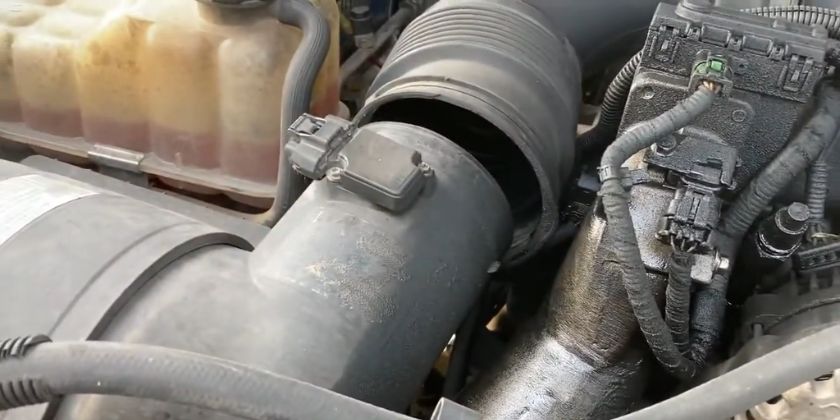
The issues we’ve discussed so far are based on the DTC codes your scanner gets.
But what if you get the reduced engine power message without any DTC code?
The first thing you should check in such cases is the mass airflow sensor (MAF).
The MAF sensor calculates the amount of air entering the engine so that the ECM can inject the correct amount of fuel for an ideal air-fuel ratio.
Based on my observations, the air filter can sometimes spill some oil on the MAF sensor, causing it to contaminate.
The sensor starts to malfunction due to these contaminations and sends incorrect readings to the ECM, which results in rough idling, poor fuel efficiency, or hesitation during acceleration.
The ECM considers these issues to be a problem with the engine itself and triggers the warning message.
7. MAP Sensor
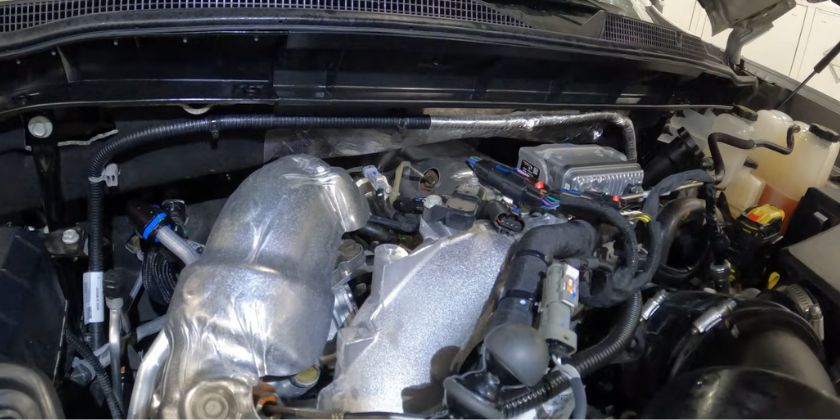
The MAP (Manifold Absolute Pressure) sensor calculates the pressure in the intake manifold in real-time.
This information is vital for the engine to determine the ignition timing and that how much fuel is needed for each cylinder.
If this sensor malfunctions in a turbocharged engine, the ECM receives readings that are lower than the actual pressure, leading it to believe that the turbocharger is not providing a sufficient boost.
This discrepancy can trigger the ECM to generate the P0299 DTC code.
If you get this DTC code along with reduced engine power, while the turbocharger itself is good, it’s time to inspect the MAP sensor.
In most cases, this problem doesn’t occur due to physical damage. Instead, the MAP sensor gets dirty from soot found in engine smoke.
So, clean this sensor with a MAP sensor cleaner and replug it to see if the issue is fixed. If it doesn’t, you can try a new MAP sensor.
8. Oxygen Sensor
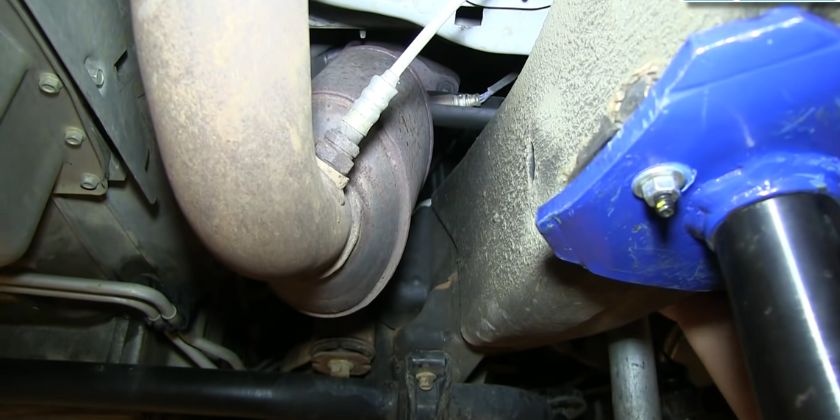
If your Duramax engine’s MAF and MAP sensors are good, it’s time to check the Oxygen sensor.
Also known as the O2 sensor, the oxygen sensor measures the centration of unburned oxygen in the exhaust and sends that information to the ECM.
The ECM uses this information to adjust the air-fuel mixture for optimal combustion.
If this sensor goes bad, it can send wrong information to the ECM and make it add more air into the combustion chamber.
This extra air will cause the air-fuel mixture to get lean, resulting in decreased fuel efficiency, higher emissions, and loss of power.
9. Air Filter
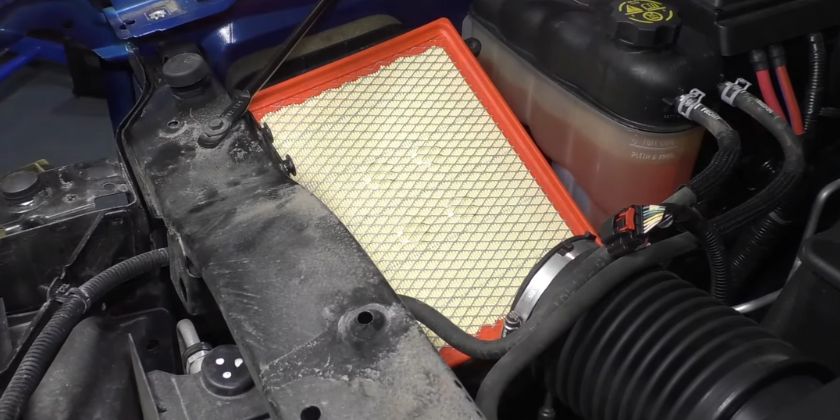
The air filter is another seemingly trivial component that can reduce the power of your Duramax engine.
Located on the top or side of the engine, its job is to purify the air entering the engine from dirt, dust, debris, and other particles – as they can damage the engine’s internal parts.
This filter can get clogged over time and can prevent the air from passing through it.
Due to this, the engine will get a lesser amount of air, affecting the air-fuel mixture and leading to increased fuel consumption and decreased engine power, as a result.
10. Fuel System
The fuel system is another area you need to check for this warning message, especially if there are P0087 or P0191 codes on your OBD-II scanner.
Although it consists of a lot of different components, they are related to each other, and an issue with one of them can cause a domino effect.
That’s why I decided to cover all of them in one go.
Fuel Filter
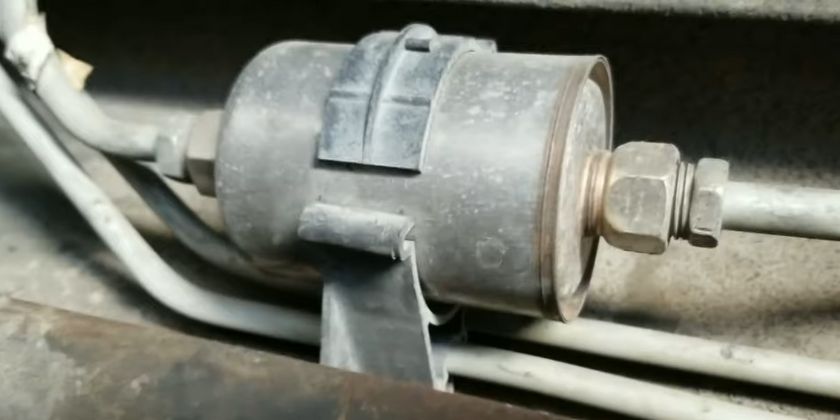
The first thing you should check in the fuel system is the fuel filter.
As the air filter cleans the air coming into the engine, the fuel filter purifies the fuel going into the combustion chamber.
This filter can get clogged with debris and partially block the fuel, resulting in less fuel entering the combustion chamber.
The inadequate fuel supply can negatively affect the air-fuel mixture, leading to incomplete combustion and reduced engine power.
Therefore, check your fuel filter and replace it if it’s dirty.
Fuel line
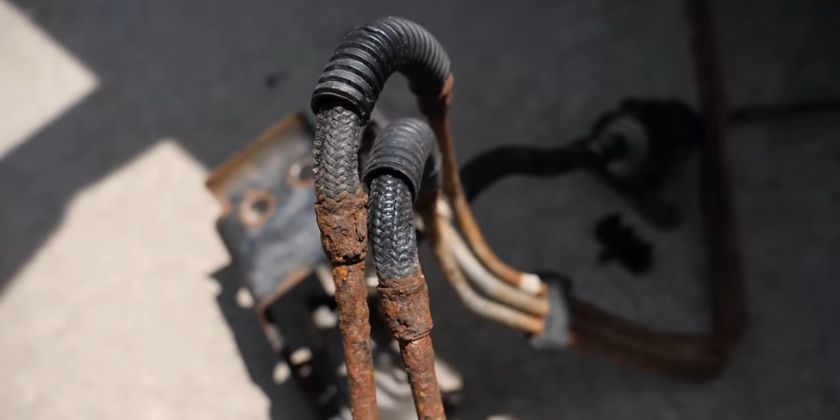
Next, we’ll check the fuel lines. These are the pipes that transfer fuel from the tank to the engine.
If this line gets damaged, it’ll start to leak oil, resulting in the drop in fuel pressure. The ECM will detect this pressure drop and trigger the P0087 code.
In such a case, you should examine the fuel line and replace it if it’s rusty or leaky.
Fuel Pressure Regulator

If the fuel filter and lines are good, it’s time to check the fuel pressure regulator. This regulator controls the pressure on the fuel in the fuel rail.
If this regulator goes bad, the rail will have inconsistent fuel pressure, meaning the injectors may get too much or too little fuel.
In both cases, the engine will not work at its usual, and you’ll get reduced power. To confirm whether that’s the case or not, you can hire a mechanic to test the fuel pressure with a fuel pressure gauge.
Replace the regulator if the fuel pressure is out of range.
Fuel Rail Pressure Sensor
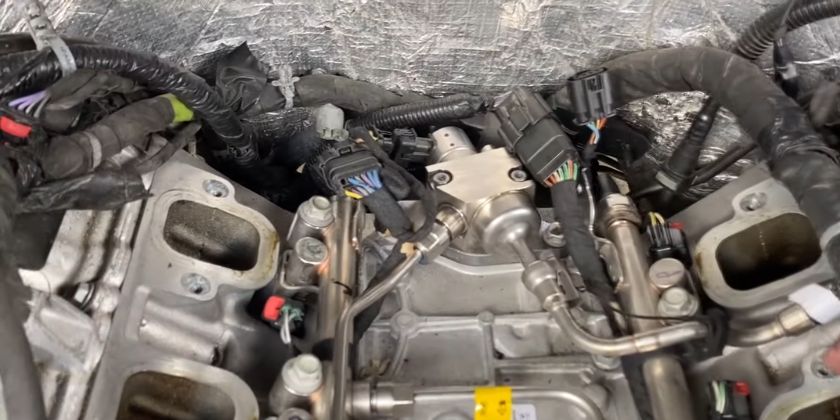
Sometimes, you get the out-of-range fuel rail pressure readings due to a faulty fuel rail pressure sensor.
Yes, Duramax vehicles have a fuel rail pressure sensor that can send incorrect pressure readings to the ECM, leading it to believe that there’s some issue with the fuel pressure.
Therefore, if you get the P0191 code while other fuel system components are working fine, the fuel rail pressure sensor is likely to be the culprit.
In many cases, the sensor isn’t physically damaged but malfunctions due to accumulated debris coming from the road.
Fuel Injectors
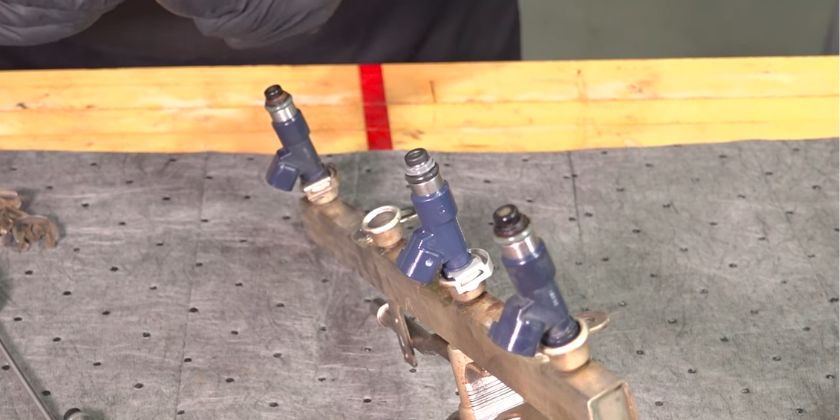
Fuel injectors are another fuel-system component that can reduce the engine power in your Duramax vehicle.
As they’re responsible for injecting the right amount of fuel into the combustion chamber, a faulty fuel injector may not spray fuel evenly into the combustion chamber.
This can result in an uneven air-fuel mixture, leading to incomplete combustion and reduced power.
As for the fix, you’ll need to clean these injectors if they’re clogged due to contaminations or replace them if they’re physically damaged.
Fuel Pump
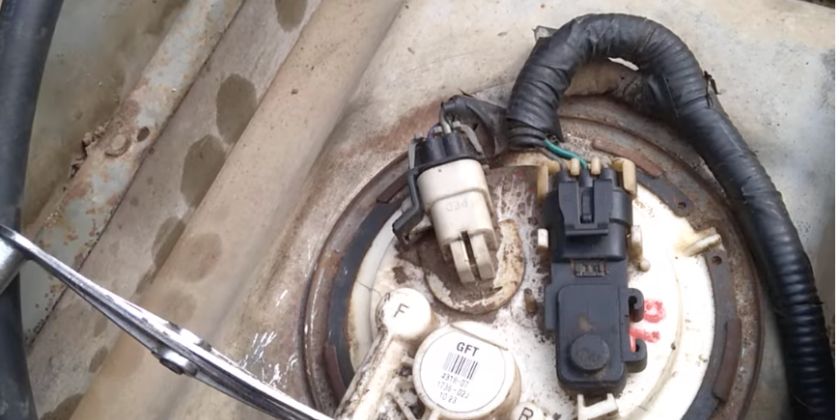
The last fuel system component you can check is the fuel pump itself.
Like other fuel-related components, it can get clogged over time due to sediment buildup, which results in insufficient fuel supply.
This insufficient supply leads to a lean air-fuel mixture, which in turn leads to reduced engine power.
The issue can also trigger the P0087 code as a clogged fuel pump will not be able to maintain the required fuel pressure.
To fix this issue, you’ll need to replace the fuel pump.
12. Deisel Exhaust Fluid
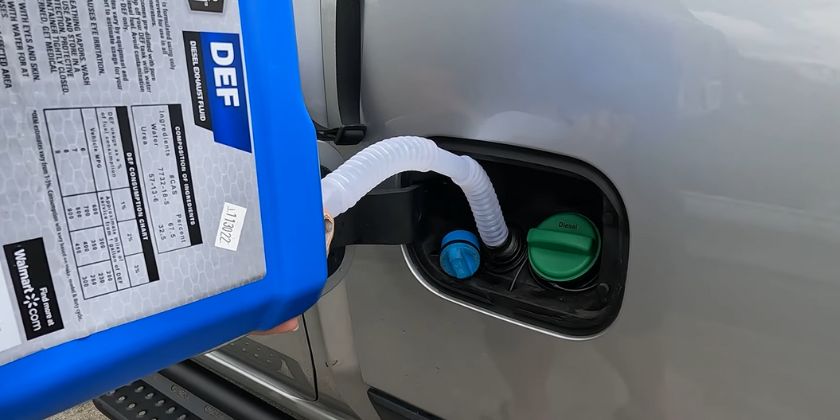
The DEF is a liquid used in diesel engines, such as Duramax, to reduce the amount of air pollution.
When this fluid gets low, the Selective Catalytic Reduction (SCR) system cannot perform the chemical reactions required to convert nitrogen oxide (NOx) into nitrogen and water vapor.
This increases harmful nitrogen oxide emissions from the diesel engine, contributing to air pollution.
The ECM detects the problem and reduces the engine power as a countermeasure.
This issue is rather easy to fix, as you only need to refill the fluid in the DEF tank.
However, if you’ve recently refilled the DEF and have been getting the reduced engine power message since then, the fluid you filled was of low quality.
In such a case, you should drain the DEF tank as soon as possible before refilling it with new, high-quality fluid.
13. EGR Valve
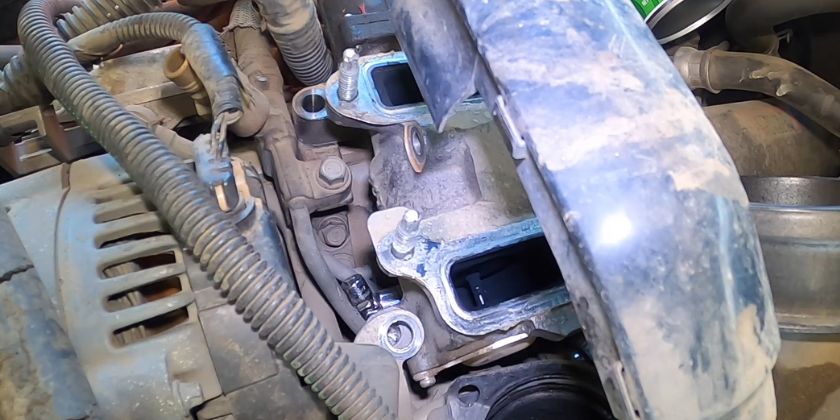
The EGR (exhaust gas recirculation) valve is a component found in the exhaust system and is responsible for introducing small quantities of exhaust gas back into the combustion chamber.
This results in a lesser amount of harmful nitrous oxide particles, as they’re essentially being burned for the second time.
The reintroduction of exhaust gas also dilutes the level of oxygen, which causes the fuel to combust completely, resulting in reduced fuel consumption (due to better efficiency).
The carbon deposits can build up over the EGR valve over time, causing it to stuck open or close.
If it’s stuck open, the air-fuel ratio will be disrupted, resulting in rough idling and poor engine performance.
On the other hand, if it’s stuck close, the exhaust gas will not re-enter the combustion chamber, leading to higher combustion temperatures and increased NOx emissions (bad for the environment).
In both cases, there is a possibility of the ECM triggering the reduced engine power message.
Conclusion
If you’ve tested all of the components mentioned above, there is a high chance that you’ve diagnosed and fixed the cause for the reduced engine power message.
If you haven’t, I recommend consulting the dealership, as the issue is likely to be with the ECM or PCM itself, especially if you got the U0401 or P0641 code.
Frequently Asked Question
How to Bypass Reduced Engine Power?
There’s no single way to bypass the reduced engine power warning message.
Instead, you’ll need to diagnose the vehicle and find the underlying issue that caused the ECM to trigger this message in the first place.
That said, sometimes this message can appear due to an electrical glitch. In such a case, you try to reset it by disconnecting and reconnecting the negative battery terminal.
What Causes Duramax to Go into Limp Mode?
There are many issues that can cause a Duramax vehicle to go into limp mode, such as a dirty throttle body, low fuel rail pressure, clogged fuel filter, bad turbocharger vane actuator, etc.
Can a Dirty Air Filter Cause Reduced Engine Power?
Yes, a dirty or clogged air filter can obstruct the flow of air coming into the engine. This will affect the air-fuel mixture and can result in a reduced engine power message.
What Sensors Can Cause Limp Mode?
The sensors that can cause a vehicle to go into limp mode upon malfunctioning include the mass airflow (MAF) sensor, throttle position sensor (TPS), accelerator pedal position (APP) sensor, manifold absolute pressure (MAP) sensor, and fail rail pressure (FRP) sensor.
Is it Safe to Drive With Reduced Engine Power?
Yes, you get to drive with the reduced engine power message for shorter distances. This message will probably put your vehicle into limp mode, where the max speed will be 30 or 45 MPH so that you can drive it safely to the dealership.
I won’t recommend driving for longer durations without fixing this warning message, as the underlying issue can severely damage the engine.

